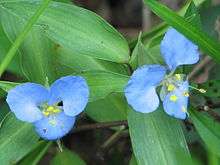Commelina virginica
| Commelina virginica | |
|---|---|
 | |
| Specimen at the Congaree National Park in South Carolina, United States | |
| Scientific classification | |
| Kingdom: | Plantae |
| (unranked): | Angiosperms |
| (unranked): | Monocots |
| (unranked): | Commelinids |
| Order: | Commelinales |
| Family: | Commelinaceae |
| Subfamily: | Commelinoideae |
| Tribe: | Commelineae |
| Genus: | Commelina |
| Species: | C. virginica |
| Binomial name | |
| Commelina virginica L. | |
Commelina virginica, commonly known as the Virginia dayflower, is a perennial herbaceous plant in the dayflower family. It is native to the mideastern and southeastern United States, where it is typical of wet soils. While most members of the genus have thin, fibrous roots, the Virginia dayflower is relatively unique for its genus in having a perennial rhizome. The plant was first described by Carolus Linnaeus in his 1762 publication of the second edition of Species Plantarum.[2] A phylogenetic study based on the nuclear ribosomal DNA region 5S NTS and the chloroplast region trnL-trnF, two commonly used gene regions for determining relationships, suggested that Commelina virginica is most closely related to two African species, namely Commelina capitata and Commelina congesta. However, the statistical support for this result was low. morphologically speaking the supposedly related species do share some unique traits. C. virginica and C. capitata have red hairs at the top of their leaf sheaths, an unusual character in the genus, while C. virginica and C. congesta both have clustered inflorescences on very short stalks.[3]
References
- ↑ "Commelina virginica". NatureServe Explorer. NatureServe. Retrieved 2008-08-25.
- ↑ Faden, Robert (2006). "Commelina virginica". In Flora of North America Editorial Committee, eds. 1993+. Flora of North America online. 22. New York & Oxford: Oxford University Press. Retrieved 2008-08-25.
- ↑ Burns, Jean H.; Faden, Robert B.; Steppan, Scott J. (2011), "Phylogenetic Studies in the Commelinaceae Subfamily Commelinoideae Inferred from Nuclear Ribosomal and Chloroplast DNA Sequences", Systematic Botany, 36 (2): 274, doi:10.1600/036364411X569471
External links
 Media related to Commelina virginica at Wikimedia Commons
Media related to Commelina virginica at Wikimedia Commons- Profile at Flora of Missouri Webpage
- Profile at USDA PLANTS Database
